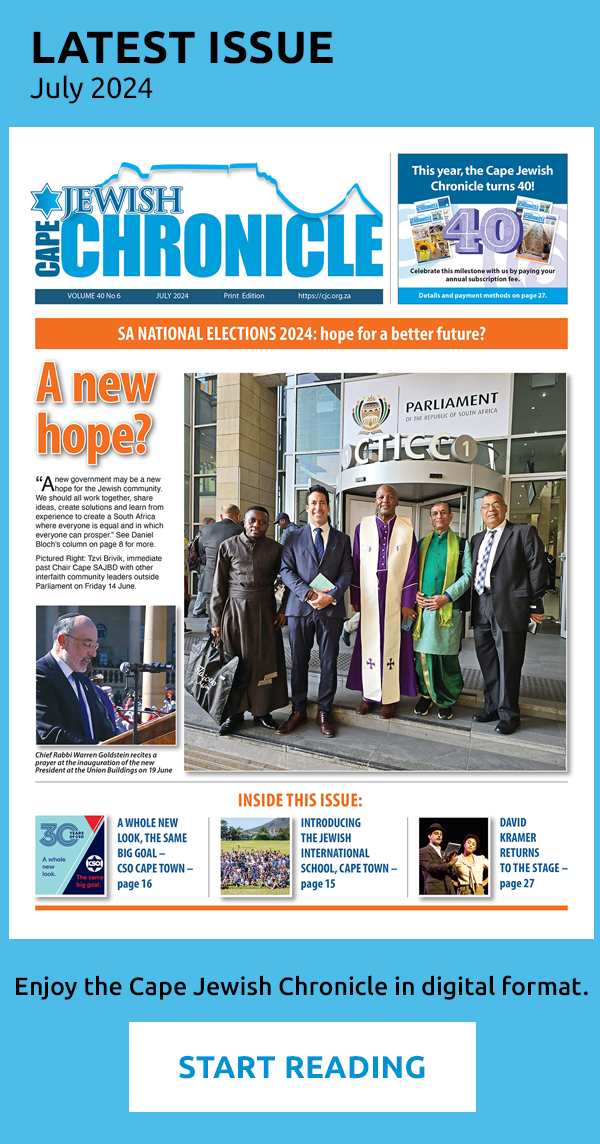By Gwynne Robins, Senior Researcher, Cape SAJBD
Long before Adolf and Mary Arnholz set up shop in Ceres in 1865, Ceres was under the sea off Gondwanaland, and marine fossils 400 million years old are still to be found in the surrounding mountains.
Like the sea creatures which thrived and vanished, leaving behind their fossils, so too did the Ceres Jewish population (which once boasted a Tikvah Zion Society, Junior Zionist Society, Ladies Benevolent Society, Chevrah Kadisha, Bnoth Zion and Union of Jewish Women), leaving behind their synagogue — now a conference centre and offices — their cemetery with 45 graves, and an exhibition in the Togreyers (Transport Riders) Museum.
Ceres is located in a fertile valley set between mountains often snow-capped in winter. The climate is ideal for growing deciduous fruit, and the Jewish community played a major role in this enterprise. David Cohen and his son Losky became known as the Seed Potato Kings of the Western Province, while Theo Kirch, a founder of Ceres Fruit Growers, was called the Plum King. Joseph Sarembock pioneered the scientific growing of apples and other deciduous fruit in South Africa, and with his brothers Louis and Jack, imported fruit trees from New Zealand, Australia, Canada and California.
The first Jews to settle in Ceres were shopkeepers Adolf and Mary Arnholz, who arrived from Germany in 1865, and were followed by Adolf’s brother, Bernhard. The Baumanns also came from Germany, arriving in 1870. They had a shop there until 1923. Mr and Mrs Ring moved to Ceres in 1889. Adolph and Amelia Sebba arrived in 1895. Three years later, by the time Herman Daneman and his wife settled there, Lazarus Goldberg and Abraham Hillel Miller had founded the Ceres Tikvah Zion Society. Mr C Fisch, Morris Green, Mr Katzen and the two Frank brothers were living in the town around 1900, as were photographers Fisher and Smolensky at their Premier Art Studio, and the Raskin family who sold mineral water. By 1903 there were sufficient Jews to form the Ceres Hebrew Congregation.
They made considerable contributions to the area’s civil, agricultural and economic development. Adolph Arnholz, founder of the Inland Transport Company which operated horse-drawn passenger coaches from Cape Town to the Kimberley diamond fields, was appointed the first Ceres magistrate, and as a member of the Divisional Council, was responsible for the proclamation of Ceres as a magisterial district. Bernhard Arnholz was the town’s first Justice of the Peace, and its Mayor in 1873.
In April 1920 Mr Sebba, Ceres Zionist Society president, expressed his thanks to the British government and General Smuts for their effort in restoring Palestine as a Jewish national home, holding a thanksgiving service and banquet in July at the home of Mr and Mrs Frank Fish.
In 1923 Mr Baumann, chairman of the congregation, laid the foundation stone for its synagogue on the corner of Porter and Munnik Street opposite the Belmont Hotel. Two years later they established a cemetery in Owen Street, and the Ceres Zionist Association started a fund to build a hall on land bought with money from the Ladies Benevolent Society. It was erected in 1933 and also served as a Talmud Torah.
The Jewish community reached its peak in the 1930s, by which time antisemitism was on the increase. In 1935, after being refused permission to meet in the town itself, the Gentile Protection League held a meeting on a farm on 9 August. A Sunday Times report on 19 September 1937 covered the resignation of three town councillors, EW Krige, LE Cohen and GG Baysken, objecting to the use of antisemitic propaganda in the most recent municipal election.
The congregation, which already included the Prince Alfred Hamlet Jews, amalgamated with Wolseley and Tulbagh in 1944 under the chairmanship of Mr M Friedman. In 1953, when the Allies distributed ceremonial silver looted by the Nazis, SAJBD gave them a silver yad. But already the community was shrinking and by 1964 there were only 17 families in the Ceres-Wolseley Hebrew congregation.
Then tragedy struck. Although earthquakes were relatively unheard of in South Africa, one measuring 6.3 on the Richter scale struck Ceres and Tulbagh on 29 September 1969, during a meeting of the women’s organisations at Minnie Yamey’s home. It was the strongest to shake South Africa since measurements were first taken around 1900. Tremors could be felt as far as Cape Town and Johannesburg, and caused significant damage to properties including the synagogue, the hall and some tombstones. Fortunately, they salvaged their three Sifrei Torah from the wreckage, storing them in the original Aron Kodesh which had been used before the shul was built. Services were held in a temporary steel construction.
After the disaster, the community picked themselves up, started fundraising and four years later on 31 January 1973, consecrated a new Ceres-Wolseley synagogue and communal hall. Wolf Metter unveiled the plaque and Rabbi Prof J Newman officiated, assisted by Cantor Philip Badash and the Green Point and Sea Point Hebrew Congregation choir.
Cheder classes continued and from 1984, when numbers dropped further, Sylvia and Izzie Wolman would travel weekly from Cape Town to run the Talmud Torah. By the time the Kahn family of Prince Alfred Hamlet celebrated the bat mitzvah in 1985 of Jackie, daughter of Jos and Gwen Kahn, and in 1987 of Robyn, daughter of Michael and Maureen Kahn, the congregation comprised only two families each from Ceres and Wolseley, three from Prince Alfred Hamlet, and one each from Drostdy and the Koue Bokkeveld region.
By 1994 the synagogue was only used on Yom Kippur, with the last service held in 1996. From 1999 it was let to a school before finally being sold to the Du Toit Farming Group who converted the building into a conference centre and offices. The benches and one of the bimah cupboards went to Wynberg Shul and then to the restored Hermanus synagogue. The cemetery has been kept in good condition over the years and in 2002 Jos Kahn supervised its restoration.
Much of the information in this article comes from Jewish Life in the South African Country Communities, Volume II, researched by the South African Friends of Beth Hatefutsoth.
The Cape SAJBD Country Communities subcommittee looks after the cemeteries of the defunct country communities. For queries, contact danielb@ctjc.co.za

Ceres Togreyers Museum 
Ceres cemetery
Cape SA Jewish Board of Deputies website: www.capesajbd.org, Instagram, and Facebook page.
• Published in the PDF edition of the October 2021 issue – Click here to get it.
• Sign up for our newsletter and never miss another issue!
• Please support the Cape Jewish Chronicle with a voluntary Subscription. For payment info click here.
• Visit our Portal to the Jewish Community to see a list of all the Jewish organisations in Cape Town with links to their websites.
Follow the Chronicle: Facebook | Instagram | Twitter | LinkedIn













Joe Sarembock was my Great granddad, this has been a great read thank you, i’m surprised i haven’t come across this earlier.
Thanks David!
Louis Sarembock was my Grandfather, unfortunately he died before i was born but I have a wonderful story about my Grandmother. Let me know if you would like me to send you her amazing experience in hiding during the war in Holland.
Allan Wolman – Tel Aviv
Hi Allan, please do email our editor Desrae Saacks – editor@ctjc.co.za – about this story. Many Thanks
Dear Allan
Im the Manager at the Transport Riders Museum in Ceres. Do you ( or the family) maybe have a photograph of Joseph Sarembock ?
Regards
Bertdene Laubscher (togryersmuseum@gmail.com)
Wow! I am a grandson of Joe & Jane Sarembock (eldest son of Cyril & Sarah) and live in Cincinnati, Ohio. I have a photo of Joe Sarembock ~1915. Send me your e-mail and I will attach a digital copy. Mine is
sarembock@me.com
Wow! I am a grandson of Joe & Jane Sarembock (eldest son of Cyril & Sarah) and live in Cincinnati, Ohio. Would love to hear the stories…. My e-mail is sarembock@me.com
Chag Sameach!
IJS